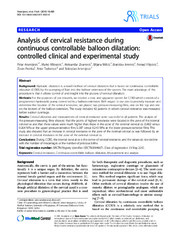Приказ основних података о документу
Analysis of cervical resistance during continuous controllable balloon dilatation: controlled clinical and experimental study
| dc.creator | Arsenijević, Petar | |
| dc.creator | Milošević, Marko | |
| dc.creator | Živanović, Aleksandar | |
| dc.creator | Miličić, Biljana | |
| dc.creator | Jeremić, Branislav | |
| dc.creator | Filipović, Nenad | |
| dc.creator | Protrka, Zoran | |
| dc.creator | Todorović, Petar | |
| dc.creator | Arsenijević, Slobodan | |
| dc.date.accessioned | 2020-07-02T12:57:11Z | |
| dc.date.available | 2020-07-02T12:57:11Z | |
| dc.date.issued | 2015 | |
| dc.identifier.issn | 1745-6215 | |
| dc.identifier.uri | https://smile.stomf.bg.ac.rs/handle/123456789/1993 | |
| dc.description.abstract | Background: Hydraulic dilatation is a novel method of cervical dilatation that is based on continuous controllable dilatation (CCBD) by the pumping of fluid into the balloon extension of the system. The main advantage of this procedure is that it allows control of and insight into the process of cervical dilatation. Methods: For the purposes of our research, we created a new and upgraded system for CCBD which consists of a programmed hydrostatic pump connected to a balloon extension. With regard to our aim to precisely measure and determine the location of the cervical resistance, we placed two pressure-measuring films, one on the top and one on the bottom of the balloon extension. This study included 42 patients in whom cervical resistance was measured before suction curettage. Results: Cervical dilatation and measurement of cervical resistance were successful in all patients. The analysis of the pressure-measuring films showed that the points of highest resistance were located in the zone of the internal cervical os and that these values were much higher than those in the zone of the external cervical os (0.402 versus 0.264 MPa at the upper pressure-sensitive film; 0.387 versus 0.243 MPa at the lower pressure-sensitive film). This study also showed that an increase in cervical resistance in the zone of the internal cervical os was followed by an increase in cervical resistance in the zone of the external cervical os. Conclusions: During CCBD, the internal cervical os is the centre of cervical resistance, and the values do not decline with the number of miscarriages or the number of previous births. | en |
| dc.publisher | BMC, LONDON | |
| dc.relation | Ministry of Education, Science and Technological Development - Serbia | |
| dc.rights | openAccess | |
| dc.source | Trials | |
| dc.subject | Cervical resistance | en |
| dc.subject | Continuous controllable balloon dilatation | en |
| dc.subject | Measurement and analysis | en |
| dc.title | Analysis of cervical resistance during continuous controllable balloon dilatation: controlled clinical and experimental study | en |
| dc.type | article | |
| dc.rights.license | ARR | |
| dcterms.abstract | Живановић, Aлександар; Aрсенијевић, Слободан; Тодоровић, Петар; Протрка, Зоран; Aрсенијевић, Петар; Јеремић, Бранислав; Милошевић, Марко; Миличић, Биљана; Филиповић, Ненад; | |
| dc.citation.volume | 16 | |
| dc.citation.other | 16: - | |
| dc.citation.rank | M23 | |
| dc.identifier.wos | 000363503800001 | |
| dc.identifier.doi | 10.1186/s13063-015-1003-8 | |
| dc.identifier.pmid | 26510412 | |
| dc.identifier.scopus | 2-s2.0-84945548793 | |
| dc.identifier.fulltext | https://smile.stomf.bg.ac.rs/bitstream/id/640/1988.pdf | |
| dc.type.version | publishedVersion |


